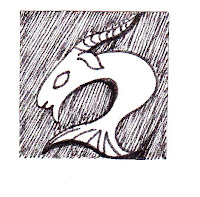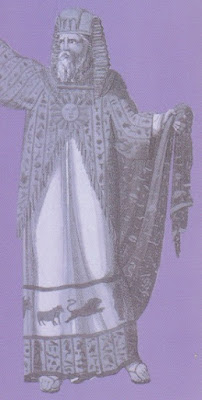1361 TUTANKHATEN -r.c.1361-1352 (New Kingdom) is son and successor of the heretical king Akhenaton. He changed his name to Tutankhamun (Tutankhamen) to bring him in line with a return of Egypt to the religion of Amon. Childless, Tutankhamen was succeeded to the throne by three military men, in order they were Ay, Horemheb and Rameses I, none of whom had royal blood.
Around this time there is evidence of astrology in practice in eastern Turkey.
4 faces of King Tut [Time Life Books 1987]
1338 This is the time of an estimated total eclipse over Akhetaten, city of Akhenaten, in ancient Egypt Dynasty XVIII. In astrological terms this coincides with the turmoil of a reconstruction of the societies of Egypt and the Hebrews.
1320 RAMESSES I [r.c.1320-1318 BCE] Vizier of Horemheb, takes the throne of Egypt as founder of Dynasty XIX. Ramesses I had a very short reign of only two years but managed to decorate at Karnak and construct at Abydos, the latter building being completed by his son Sethos I. Ramesses tomb holds decorations from the ‘Book of Gates’.
Around 1315 BCE, the writing of the ‘Old Testament’ follows on the ‘Exodus’ of the Hebrew people from Egypt and the conversion of the Israelites to One God, which may echo the one source god of Akhenaton. The Hebrews then become known in Palestine as the Jews.
1309 SETHOS I /SETEKHY I (1309-1291 or 1291-1278 BCE) also called Seti I, Sethos I, is son of Ramesses I. He builds a temple at Abydos over more ancient remains. In a hallway of this temple is located the ‘Gallery of the Lists’ decorated with a relief carving called the ‘Table of Abydos’ which depicts a modified king list, leaving out some names, most notably the name of Hatshepsut. The list contains the names of 76 kings, claimed by Sethos to be his ancestors. In the temple, there is a daily performance of the ‘Ritual of the ‘Royal Ancestors’. It is noted that the physical characteristic of Setekhy I, Rameses II and Mer-en-Ptah of the 19th Dynasty, indicate a different race to those of previous dynasties. (80) On the vaulted ceilings of the 10 chambers in the Temple of Sethos I, are recorded the zodiac signs.
Among his many achievements, Sethos I will take possession of Palestine, engage in battle with the Hittites and established a water-station (well) on the route from the Nile Valley to the gold mines in the eastern desert. Seti also restored ruined sanctuaries, including the above mentioned Temple of Abydos, which has the unique feature of seven chapels. Each chapel is dedicated to one god, vis:- the King or Pharaoh, Ptah, Harakhit, Amon (central chapel on the axis of the temple) Osiris, Isis, Horus. The axis of this Seti temple is in line with the underground Osireion, tomb and place for the celebration of the mysteries of Osiris, that lies behind the temple, and is also rebuilt by Sethos. (80)
Pharaoh Setekhy/Seti, whose Ka-name is ‘Repeater of births’, is buried in the Thebes Valley of Tombs. His tomb is cut 300 feet into the rock with walls and ceilings decorated with sculpture and painting depicting the ‘Journey of the Sun through the Realms of Night’. Seti’s revival of the worship of the god of darkness Setekh, as evidenced by the incorporation of the name Setekhy, meaning ‘He of Setekh’, that is, of the god Setekh/Sutekh, (80) Greek Seth, English Set. In a side room of his Seti’s tomb is the wall carving of the Divine Cow near which is inscribed the famous legend of the ‘destruction of men’ when they revolted against their Creator.
Gods Set and Horus pouring out life over Seti I [Budge, Gods]
SETEKH god of Egypt is also known as Set, Seth, Sethy, Setesh, Setech, which may mean ‘to intoxicate’, referring to the concept of divine intoxication. This god is also known as Nubti an early dynasty sky god symbolised by an unidentified long snout animal with square ears, and the ‘Was Scepter’. Setekh is an important Egyptian god, the earliest example being that decorating the mace-head of the early Scorpion-King [3400 BCE]. Setekh had the same epithet as applied to Re, ‘Majesty’, until about 22nd Dynasty when he became the symbol of evil. Brother and helper of Osiris, Seteckh/Set shared rule of Egypt with the falcon god Horus the Elder.?) The chief seat of Setekh’s worship is the city of Nubt; he is known to the Greeks as Typhon or Bebon. The root of Bebon is Beb meaning ‘eddy’, either of water or air, thus connecting the god to the whirling pillars of desert sand. Over the course of Egypt’s long history, the god went from being a power of nature, Darkness, to a personification of moral and physical evil. (80. 302)
c1300 MIRIAM Hebrew/Israelite prophetess and older sister of Moses and Aaron, plays a significant role in the liberation of the Hebrew people from Egypt. Miriam challenged Moses spiritual authority and was punished by Yahweh according to existing writings.
At this time, an Egyptian Papyrus records a calendar of lucky and unlucky days. With it are tables of the risings of stars with corresponding gods for each hour, day and month. There is emphasis given to the numbers 7 and 12. At this time the Vernal Equinox occurs against the background of the constellation of Perseus.
ORPHEUS of Thrace and of royal parentage, is the son of a priestess of Apollo and destined to unite the warring solar and lunar cults after returning from a sojourn to Egypt to study the mysteries. Orpheus blended the religion of the Greek Zeus with that of Dionysus who was believed to have originated in Egypt. The aim was to replace the primitive cult of the Bacchantes who had combined the cult of threefold Hekate with the old cult of Bacchus.
The sanctuaries of Apollo kept the Orphic tradition whose festival was celebrated at the Vernal Equinox when the god returned in a chariot drawn by swans marking his re-birth.

When the Cosmic Harp rings out the rhythms of the Universe.
In Mesopotamia of the Upper Euphrates, Mitannian (1300 BCE+) sources list Varuna, Mitra, Indra and the twin god Nasatyas of ancient Iranian (Persian) religion. They come from the same common Aryan heritage as the Indian mythology. Out of the Indo-Iranian cults of fire worship, symbolised by the goddess of light Mitra, will come the Mithraic worship. Mithraism is to become a widespread mystery cult in the east. The goddess Mithra will be resurrected in Zoroastrianism (c580 BCE) as the ‘Eye of Mazda’. Mithraism will penetrate the old mystery religions during the Hellenistic period of Greek civilization of the future and which will follow on from the time of Alexander the Great (c300 BCE). This mystery religion will again surface fully in the west in 1st century CE during Roman times. Mithraism had 7 grades of initiation, leading to immortality. As part of its ritual, the rite of slaying the bull was seen as a re-enactment of Mithra killing the cosmic bull of creation.

The purifying force of Fire & Light






















